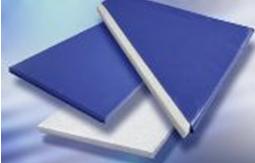For durable, hard-wearing and safe sports mats, BASF offers Neopolen® E, an expanded polyethylene (EPE). The lightweight foam can be used as core material for gym mats because it keeps its resilience and has an optimal energy absorption behavior even after heavy use. Lightweight gym mats are primarily used for floor exercises in school sports. They therefore need to have good impact-absorbing qualities and low weight in order to retain their shape and to give value for money in the long run.

Long-lasting resilience
Neopolen E is a closed-cell, physically crosslinked particle foam made of polyethylene, which means that the number of connections between the individual molecules is higher than in the non-crosslinked material. Because of this finer cell structure, mat cores made of Neopolen E are more stable and keep their shape longer. After loading, they absorb the energy and quickly revert to their original shape. Sports mat cores made of Neopolen E are therefore more resilient than cores made of non-crosslinked polyethylene, which can lose their shape after a short period of usage. The consistently good cushioning properties of the BASF material also reduce the likelihood of sports injuries because the gymnast can keep a firm standing position. The elasticity and flexibility of Neopolen E is largely retained between -70 and +85°C.
BASF supplies sports mat manufacturers with Neopolen E panels in sizes of around 2x1 meters and in thicknesses of between 40 and 120 mm. Gym mats made of Neopolen E weigh about four kilograms and are therefore around four times lighter than conventional sports mats that have a polyurethane composite foam core.
Neopolen E for packaging, vehicle manufacture and construction
Neopolen E is a specialty foam with optimal cushioning, good resilience and high elasticity. These properties make Neopolen E an ideal material for packaging, vehicle manufacturing as well as sports and leisure applications. Neopolen E also offers minimal water absorption, a long life, very good chemical and temperature resistance, being used, for example, in the construction industry as expansion cushions for long-distance heating pipes. The foam contains no chlorofluorocarbons (CFCs) or hydrochlorofluorocarbons (HCFCs) and can be recycled in different ways.